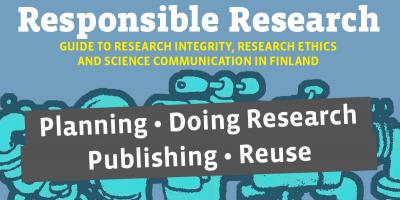The purpose of open peer review is to improve scientific communication and publishing practices.
Open peer review forms a part of a wider context of open publishing and open science. The central status of peer review in the scientific community is reflected in the recruitment processes of universities, the competition for research funding, and mechanisms of evaluation, ie. the referee system of publishing. The changes in publishing facilitated by the ethos of open science inevitably also influence the practices concerning peer review.
Aiming at a transparent research process
Currently, the dominant practice is that peer review as a part of the publishing process is conducted as a closed process. In this traditional peer review model, editors invite and select peer reviewers, who then write their evaluations independently of each other. The statements and their content are not made available or utilised outside of this closed process for making publication decisions.
A single-blind review is considered the most common type of peer review. In this type of review, the identity of the author is disclosed to the reviewer, but the reviewer stays anonymous. In a double-blind review, the identities of both the author and the reviewer are kept secret. This method is used more commonly in the arts and social sciences than in natural sciences, technology, engineering or medicine.
Because of the non-transparency, the review process contains points where various kinds of misunderstandings, but also misconduct, are possible.
The process is non-transparent in many ways to all the actors involved. Because of the non-transparency, the review process contains points where various kinds of misunderstandings, but also misconduct, are possible. Such points include, among others, the opportunity of a peer reviewer to benefit from the unpublished work of another person and/or to intentionally slow down the publication process.
The purpose of open peer review is to improve scientific communication and publishing practices. It also aims at clarifying the roles of peer reviewers, authors, scientific journals and readers, i.e., every party participating in the publishing process, as well as challenging the idea of the superiority of closed peer review.
Open peer review seeks to resolve the issues related to lack of transparency in the publishing process under the assumption that increased transparency improves the quality of the entire peer review process. Reduction of various biases and increased responsibility of actors may lead to a process generating more constructive reviews and in which the reviewers are also acknowledged for their work.
Degrees of openness
Most commonly, open peer review includes use of one or more of the following practices:
|
Open reports |
The peer review reports are published along with the paper. |
|
Open identities |
The identities of the author and the peer reviewer are not kept secret. |
|
Open participation |
The wider community (beyond just the invited peer reviewers) can participate in the peer review process. |
|
Open interaction |
Communication between the author and peer reviewer or amongst peer reviewers, is allowed and encouraged. |
Open peer review can be understood as an umbrella concept allowing several, even partially overlapping peer review models to be formed. In spite of the multitude of forms and definitions of open peer review, one of the above practices can be found in all of them, with varying emphasis. Such a definition of open peer review allows a gradual transfer towards openness, thereby encouraging openness, but not requiring full openness.
Different perspectives towards openness
The concept of open peer review as such is a complex one and demands further specification when implemented in practice. Open peer review cannot be approached as a single static entity with no history or context. When considering the peer review practices, geographical and field-specific differences as well as the cultures of different disciplines should be kept in mind.
Because of the differences between disciplines, the research results concerning the functionality of different peer review models cannot be generalised. The identity of the author is generally disclosed in natural sciences, for example, meaning that the very starting points of the review process are quite different than in the study of humanities, for example.
Open peer review cannot be approached as a single static entity with no history or context.
Open publishing and open peer review are not interdependent practices, even though the majority of journals applying open peer review to any extent also publish openly.
The development of practices concerning peer review is one way to further scientific discussion. Until now, little research has been conducted on the positions created by the current openness of science in terms of peer review practices.
As a part of our national study on peer review, we sent an online survey to parties involved with Finnish science journals in summer 2018 and interviewed Finnish book publishers utilising peer review. The purpose was to determine how the functionality of the current peer review process is perceived and how the respondents felt that increased openness would affect the fields of research and publishing. No advanced conclusions can be made based on this study, but it will act as a basis for further research.
Ph.D. Riitta Jytilä is a Researcher of Literature at the University of Turku. D.Sc. (Econ.) Mikael Laakso is Associate Professor in Information systems science at Hanken School of Economics.
Further information:
Jytilä, R., & Laakso, M. (2019). Selvitys avoimesta vertaisarvioinnista kotimaisen tiedejulkaisemisen kentällä. Tieteellisten seurain valtuuskunnan verkkojulkaisuja, no. 5, Tieteellisten Seurain Valtuuskunta. https://doi.org/10.23847/978-952-599516-9
Ross-Hellauer, T. (2017). What is open peer review? A systematic review. F1000Research, 6, 588–30. http://doi.org/10.12688/f1000research.11369.1
Tennant, J. P., Dugan, J. M., Graziotin, D., Jacques, D. C., Waldner, F., Mietchen, D., et al. (2017). A multi-disciplinary perspective on emergent and future innovations in peer review. F1000Research, 6, 1151–53. http://doi.org/10.12688/f1000research.12037.1
You might also be interested in
Tämä teos on lisensoitu Creative Commons Nimeä 4.0 Kansainvälinen -lisenssillä. Detta verk är licensierat under en Creative Commons Erkännande 4.0 Licens. This work is licensed under a Creative Commons Attribution 4.0 International license.


